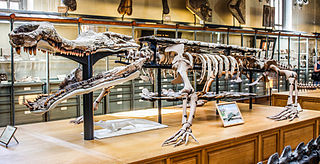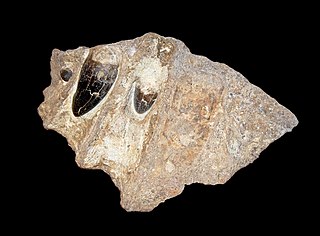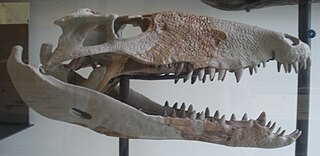
Sarcosuchus is an extinct genus of crocodyliform and distant relative of living crocodylians that lived during the Early Cretaceous, from the late Hauterivian to the early Albian, 133 to 112 million years ago of what is now Africa and South America. It was one of the largest crocodile-line reptiles, reaching an average estimate of 9 m (30 ft) and 3.5 metric tons, but estimated to grow up to 9.5 m (31 ft) in body length and weigh up to 4.3 metric tons. It is known from two species, S. imperator from the early Albian Elrhaz Formation of Niger and S. hartti from the Late Hauterivian of northeastern Brazil, other material is known from Morocco and Tunisia and possibly Libya and Mali.

Deinosuchus is an extinct genus of alligatoroid crocodilian related to the modern alligator that lived 82 to 73 million years ago (Ma), during the late Cretaceous period. The name translates as "terrible crocodile" and is derived from the Greek deinos (δεινός), "terrible", and soukhos (σοῦχος), "crocodile". The first remains were discovered in North Carolina in the 1850s; the genus was named and described in 1909. Additional fragments were discovered in the 1940s and were later incorporated into an influential, though inaccurate, skull reconstruction at the American Museum of Natural History. Knowledge of Deinosuchus remains incomplete, but better cranial material found in recent years has expanded scientific understanding of this massive predator.

Razanandrongobe is a genus of carnivorous ziphosuchian crocodyliform from the Middle Jurassic of Madagascar. It contains the type and only species Razanandrongobe sakalavae, named in 2004 by Simone Maganuco and colleagues based on isolated bones found in 2003. The remains, which included a fragment of maxilla and teeth, originated from the Bathonian-aged Sakaraha Formation of Mahajanga, Madagascar. While they clearly belonged to a member of the Archosauria, Maganuco and colleagues refrained from assigning the genus to a specific group because the fragmentary remains resembled lineages among both the theropod dinosaurs and crocodylomorphs.
Galve is a municipality located in the province of Teruel, Aragon, Spain. According to the 2006 census (INE), the municipality has a population of 145 inhabitants. There is an important paleontological site.

Terminonaris is a genus of extinct pholidosaurid crocodyliforms that lived during the Late Cretaceous epoch. The name means: “enlarged snout or nose” at the front of the skull. Terminonaris is an early crocodile, within a subgroup called Mesoeucrocodylia. Its remains have only been found in North America and Europe. Originally known under the generic name Teleorhinus, it was once believed to be a teleosaurid. Both prehistoric crocodiles such as Terminonaris, as well as modern crocodiles, belong to the same group called crocodyliformes, although modern crocodiles have specific features that indicate they are distant relatives of this species and members of the subgroup Eusuchia.

The Woodbine Group is a geological formation in east Texas whose strata date back to the Early to Middle Cenomanian age of the Late Cretaceous. It is the producing formation of the giant East Texas Oil Field from which over 5.42 billion barrels of oil have been produced. The Woodbine overlies the Maness Shale, Buda Limestone, or older rocks, and underlies the Eagle Ford Group or Austin Chalk. In outcrop the Woodbine Group has been subdivided into the Lewisville Sandstone, Dexter Sandstone, and/or Pepper Shale formations. Thin-bedded sands of the Woodbine and Eagle Ford are collectively referred to as the "Eaglebine" oil and gas play in the southwestern portion of the East Texas region.

Barinasuchus is an extinct genus of sebecid mesoeucrocodylian. Its fossils have been found in middle Eocene-age rocks of the Divisadero Largo Formation of Argentina, middle Miocene-age rocks of the Ipururo Formation of Peru, and middle Miocene-age rocks of the Parángula Formation of Venezuela.

Langstonia is an extinct genus of notosuchian crocodylomorph of the family Sebecidae. It lived in the middle Miocene, in the "Monkey Beds" of the Colombian Villavieja Formation. Langstonia was named in 2007 by Alfredo Paolillo and Omar Linares for fossils originally described by Langston in 1965 as Sebecus huilensis. Thus, the type species is L. huilensis.(Paolillo & Linares 2007)
Pabwehshi is an extinct genus of mesoeucrocodylian. It is based on GSP-UM 2000, a partial snout and corresponding lower jaw elements, with another snout assigned to it. These specimens were found in Maastrichtian-age Upper Cretaceous rocks of the Pab Formation in Balochistan, Pakistan, and represent the first diagnostic crocodyliform fossils from Cretaceous rocks of South Asia. Pabwehshi had serrated interlocking teeth in its snout that formed a "zig-zag" cutting edge. Pabwehshi was named in 2001 by Jeffrey A. Wilson and colleagues. The type species is P. pakistanensis, in reference to the nation where it was found. It was traditionally classified as a baurusuchid closely related to Cynodontosuchus and Baurusuchus. Larsson and Sues (2007) found close affinity between Pabwehshi and the Peirosauridae within Sebecia. Montefeltro et al.Pabwehshi has a sagittal torus on its maxillary palatal shelves – a character that is absent in baurusuchids – but they did not include Pabwehshi in their phylogenetic analysis.
Ayllusuchus is an extinct genus of sebecid mesoeucrocodylian. Fossils have been found in the Lumbrera Formation of Argentina.
Ilchunaia is an extinct genus of sebecid mesoeucrocodylian. Fossils have been found from the Divisadero Largo Formation of Argentina dating back to the Late Eocene, and a locality in Mendoza, Argentina dating back to the Oligocene. Little material is known from the genus, with only the anterior portion of the skull being present to study.
Kemkemia is a genus of probable crocodyliforms living in the Cretaceous, described from a single fossil in 1999 recovered from Morocco by an Italian team searching for fossil invertebrates.

The Moenave Formation is a Mesozoic geologic formation, in the Glen Canyon Group. It is found in Utah and Arizona.

Sebecus is an extinct genus of sebecid crocodylomorph from Eocene of South America. Fossils have been found in among others Patagonia. Like other sebecosuchians, it was entirely terrestrial and carnivorous. The genus is currently represented by two species, the type S. icaeorhinus and S. ayrampu. Several other species have been referred to Sebecus, but were later reclassified as their own genera.

Sebecidae is an extinct family of prehistoric terrestrial sebecosuchian crocodylomorphs. The oldest known member of the group is Ogresuchus furatus known from the Upper Cretaceous (Maastrichtian) Tremp Formation (Spain). Sebecids were diverse, abundant and broadly distributed in South America during the Cenozoic, until the Middle Miocene; although it has been suggested that at least some forms could have survived until the Miocene-Pliocene boundary in Brazil.

Stratiotosuchus is an extinct genus of baurusuchid mesoeucrocodylian from the Adamantina Formation in Brazil. It lived during the Late Cretaceous. The first fossils were found in the 1980s, and the type species Stratiotosuchus maxhechti was named in 2001. A hyperpredator, it and other baurusuchids may have filled niches occupied elsewhere by theropod dinosaurs.

During most of the Late Cretaceous the eastern half of North America formed Appalachia, an island land mass separated from Laramidia to the west by the Western Interior Seaway. This seaway had split North America into two massive landmasses due to a multitude of factors such as tectonism and sea-level fluctuations for nearly 40 million years. The seaway eventually expanded, divided across the Dakotas, and by the end of the Cretaceous, it retreated towards the Gulf of Mexico and the Hudson Bay. This left the island masses joined in the continent of North America as the Rocky Mountains rose. From the Cenomanian to the end of the Campanian ages of the Late Cretaceous, Appalachia was separated from the rest of North America. As the Western Interior Seaway retreated in the Maastrichtian, Laramidia and Appalachia eventually connected. Because of this, its fauna was isolated, and developed very differently from the tyrannosaur, ceratopsian, hadrosaurid, pachycephalosaur and ankylosaurid dominated fauna of the western part of North America, known as "Laramidia".

Cairanoolithus is an oogenus of dinosaur egg which is found in Southwestern Europe. The eggs are large and spherical. Their outer surface is either smooth, or covered with a subdued pattern of ridges interspersed with pits and grooves. Multiple fossil egg clutches are known but the nest structure is unclear.
Paluxysuchus is an extinct genus of neosuchian crocodyliform known from the Early Cretaceous Twin Mountains Formation of north-central Texas. It contains a single species, Paluxysuchus newmani. Paluxysuchus is one of three crocodyliforms known from the Early Cretaceous of Texas, the others being Pachycheilosuchus and an unnamed species referred to as the "Glen Rose Form". Paluxysuchus has a long, flat skull that is probably transitional between the long and narrow skulls of many early neosuchians and the short and flat skulls of later neosuchians.
Ogresuchus is an extinct sebecid known from the Upper Cretaceous Tremp Formation in Spain. It is the oldest known member of the Sebecidae and it is also the only known Mesozoic sebecid. The type species, O. furatus, was named in 2020.













